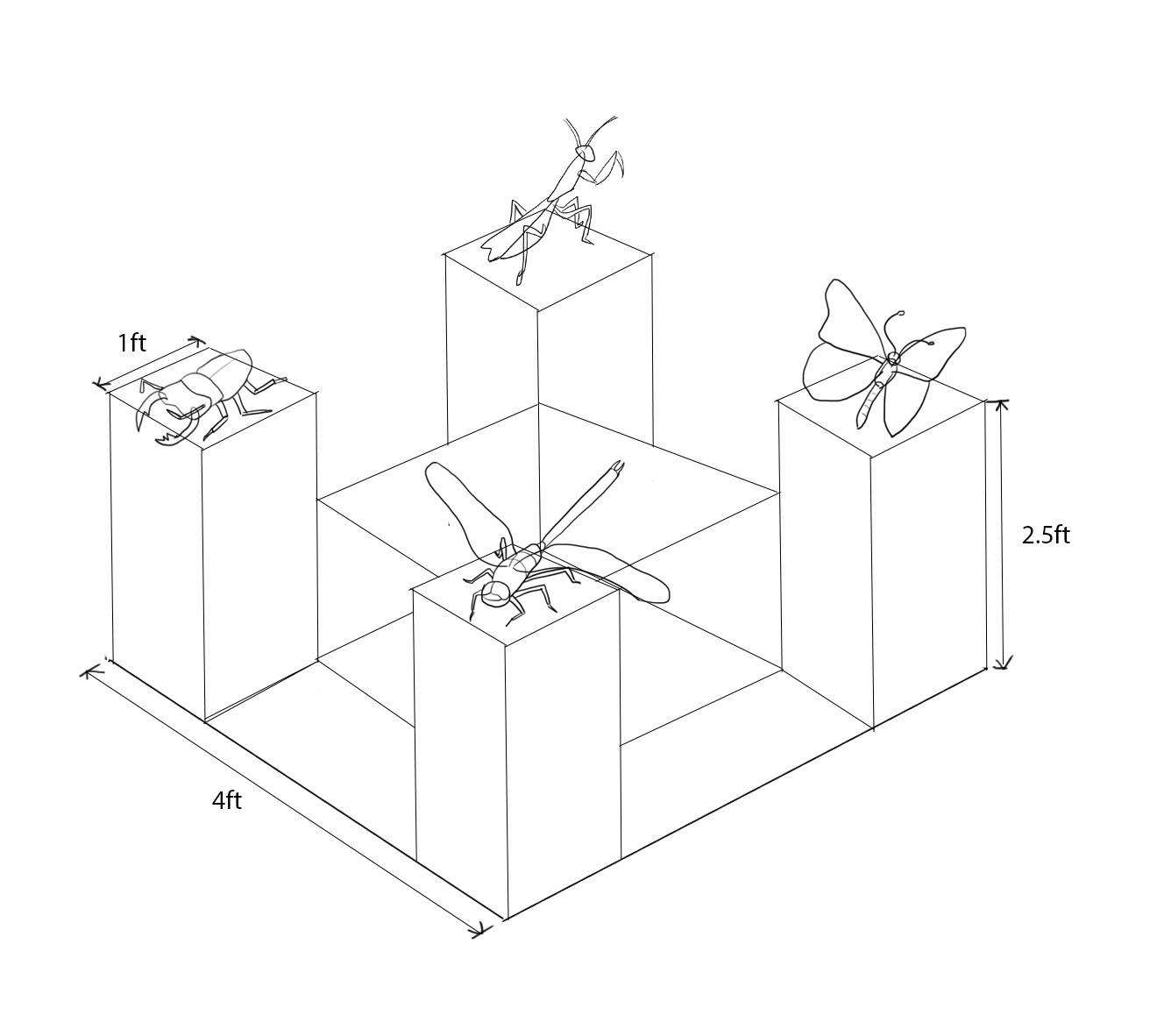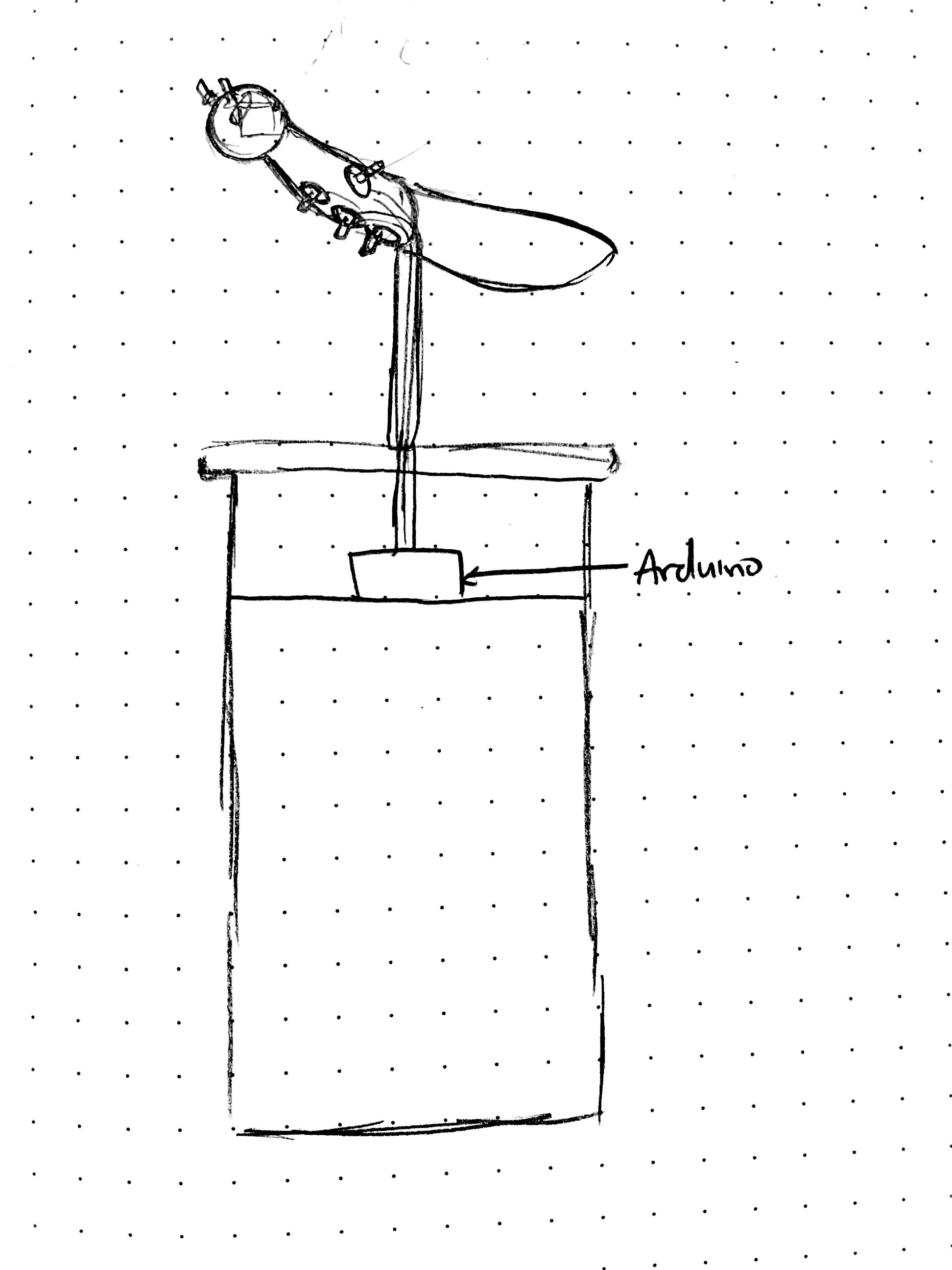Elissa Ye & Brandon Darreff

Title:
Insectopia
Preferred Museum Location:
We think the “Destination Empathy” room would be the best location for our installation because of the existing focus on animals and the environment
Narrative:
With our project we want to focus on developing an experience for museum visitors which is both interactive and educational. The plan is to create an exhibit based on various common insects and how they exist in our surrounding environment. Users will be assembling the bodies of 4 different creatures ( a butterfly, a praying mantis, a beetle, and a dragonfly) which will light up and animate once fully put together. There will be four stands placed in the corners of an implied square footprint with a central container for appendages. A base body for each insect, which will house the mechanical components necessary for the movements, will be mounted to each wooden stand at a height all users are capable of interacting with (possibly 2’-6”).
Each insect will have its own color and uniquely shaped parts. The insertion rods and cavities for each of the four will have their own diameter/ thickness to prevent parts from different insects being mixed up. Additionally, there will be a diagram on each stand visually showing the correct method of assembly. Once a limb is placed into the correct position, a light nearby on the creature’s body will light up to communicate this to the user. Once all of the parts are fully installed on a body, a light and moving animation (similar to the real movement of that particular insect) will play. As far as parts for each insect they will be as follows:
Butterfly: body (fixed), 2 wings (insertable), 2 antennas (insertable)
Praying Mantis: body and head (fixed), 2 arms (insertable), 4 legs (insertable)
Dragonfly: body and head (fixed), 6 arms & legs (insertable), 4 wings (insertable)
Beetle: body and head (fixed), 2 antennas (insertable), 6 legs (insertable)
Where possible, we will optimize the types of appendages and movement: i.e. all of the legs for the beetle will be fabricated the same and can be inserted into any of the four leg cavities and still operate or the butterfly wings will both move using one motor and be interchangeable across the two sides of the body.
Success for this project would result in the users being able to clearly understand and interact with the different insect parts. The goal is for the puzzle aspect and the animation to capture their attention.
Technical Outline:
The project stands will be constructed from either mdf or plywood with rounded/ sanded edges to prevent users from cutting themselves. We will adhere diagrams for each creature’s assembly onto their corresponding stands. Each insect will require its own arduino and power source which will be embedded inside the stands to avoid tampering from users. The sensors, LED lights, and motors will be housed inside the fixed bodies of each insect, with wires running through a mounting object into the base for attachment to the arduinos. These mounting channels will be constructed from either pvc piping or wood while the bodies will most likely be made from opaque acrylic plastic. The butterfly and dragonfly will be mounted slightly higher than the beetle and praying mantis because their primary method of travel is flying.
Each appendage will be laser cut from transparent acrylic plastic in order to capitalize on the impact of the diffused lighting. The preliminary plan is to embed magnets in each appendage and place corresponding hall sensors in the insertion points of body to control their movement. We may also consider using RFID tags for the various parts. The motors inside the bodies (both DC and Hobby Servos) will enable movement for multiple limbs at a time; we will need to explore the best method for this goal, whether that involves a system of small gears and spur racks or a tensioning system. In the code we will coordinate the rhythm of movement for the varying parts and the corresponding light animations.
Our key technical challenges for the project include the implementation of magnets/ sensors in the appendages/ bodies and the corresponding code for movement and lighting, the fabrication of curvature in the bodies, the optimization of motors and part movement, and the method of mounting the bodies to their corresponding stands. Alternative materials relevant to these issues will be explored as the project progresses (mostly in the proof-of-concept phase).


Project Management:
We will be dividing tasks in a way which allows both group members to work on all parts of the project in some respect. In other words, the plan is collaborate as much as possible for the coding side and fabrication side of the project.
For our proof of concept demonstration we intend to fabricate a rough representation of one insect body to work on the correspondence between the appendages and the motion as well as the light animation. This will allow us to analyze which fabrication methods and materials for the parts will make the most sense.
For the first on-site test the goal will be to have 2 insects and their stands in place to see how the users interact with the varying parts and colors and how they grasp the assembly process. This will allow us to see if it makes sense to add the remaining insects to the collection in a similar manner or rethink the system of differing parts to make the interaction clearer for the user. We will also be observing how the user responds to the animation and decide whether it needs to be enhanced at all.
Our unknowns at this moment are the degree to which the sensors and parts will need to interact, how that translates into the code for each piece, and the durability of the selected materials. The former two items will be addressed with our back end work however the question about durability will be answered through on-site demo.
Budget:
MDF/Plywood Sheet – ( One 4’ x 8’ Sheet) – $12.99
MDF/Plywood Sheet – ( One 4’ x 4’ Sheet) – $9.49
⅛” Transparent Acrylic Sheet – ( Four 2’ x 2’ Sheets- Varying Colors) – $44
⅛” Opaque Acrylic Sheet – ( Four 1’ x 1’ Sheets- Varying Colors)- $12
¾” x 2’ PVC Pipe – (2 Pieces) – $4
Miscellaneous Screws/ Parts- $10
Total- $92.48
Out-of-Pocket spending split evenly amongst group members
Timeline:
10/23- Project Proposal Complete
10/25- Project Proposal Revised based on feedback
10/25-10/29- Test Fabrication Methods and Sequence of Assembly for 1 Insect, Work on Code/ Coordination w/ Appendages
10/30- Proof of Concept Due and Purchase Order Submitted
10/30-11/10– Design and Fabricate Custom Appendages for 2 Insects, Design and Fabricate 2 Bases and Mounting Stands, Coordinate Appendages/Sensors w/ Code
11/11- Project Test 1 Due/ Observe at Museum
11/11-11/12- Review Observation, Revisit Project Scope & Narrative Based on Feedback, Rewrite Proposal/ Progress Report
11/13- Progress Report Due
11/14-11/19- Revise Project Test Based on Adjusted Proposal, Adjust Code
11/20- Revised Project Test Due
11/20-11/28- Fabricate Final Parts and Stands, Resolve Issues in Code, Test Interaction
11/29- Final Prototype Due
11/29-12/1- Final Preparations and Adjustments
12/2- Tentative Installation and Observation at Children’s Museum
12/2-12/3- Work on Preliminary Documentation
12/4- Preliminary Documentation Due/ Project Open House
12/4-12/5- Adjust Documentation Based on Feedback
12/6- Final Documentation Due
Leave a Reply
You must be logged in to post a comment.